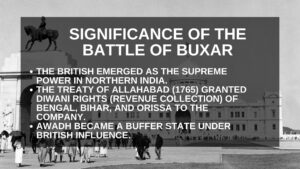India’s political and economic landscape underwent a massive transformation before and during British Rule in India. Once a land of powerful kingdoms and thriving trade, internal conflicts and foreign interventions gradually paved the way for British dominance. From the decline of the Mughal Empire to the rise of the East India Company, this era was marked by battles, shifting alliances, and economic exploitation.
Political Scenario in India
Before British rule, India was a land of diverse political entities, each struggling for dominance and power. The once-mighty Mughal Empire was in decline, paving the way for regional rulers to establish their influence.
The Mughals
Following the death of Aurangzeb in 1707, the Mughal Empire weakened significantly. The later Mughal rulers were engaged in continuous political conflicts over inheritance and dominance, leading to the empire’s fragmentation.
Download notes of Advent of Europeans in India
The Marathas
The Third Battle of Panipat in 1761 dealt a severe blow to the Maratha Empire. This loss allowed the British to consolidate their power in Bengal and South India.
The Mysore Kingdom
Hyder Ali, originally a commander-in-chief under Krishnaraja Wodeyar II, rose to power and became the de facto ruler of Mysore. His leadership posed a formidable challenge to British expansion.
The Hyderabad State
Mir Qamar-ud-Din Siddiqi, known as Asaf Jah, declared Hyderabad’s independence in 1724. However, constant invasions from the Marathas and struggles for succession led to increased interference from both the British and the French.
The Bengal Region
Murshid Quli Khan, the Nawab of Bengal, ruled as an independent power. Bengal was a thriving economic hub, producing textiles, saltpeter, and gunpowder. The region soon became the focal point of European trading interests.
Economic Situation of India Before British Rule
Agriculture
Peasants suffered under an oppressive taxation system, where revenue demands from the state, zamindars, jagirdars, and revenue farmers led to increasing poverty and hardship.
Trade and Industry
Traditional Indian merchants, such as the Bohra Muslims and Jains, faced a decline as European trading companies monopolized trade. The British East India Company leveraged its growing political power to secure trade privileges.
Society in India Before British Rule
Education
The Indian education system was rooted in traditional institutions like maktabs, pathshalas, chatuspathis, and madrasas. Sanskrit learning thrived in places like Varanasi and Mithila, while Persian and Arabic studies were centered in Patna.
Status of Women
Indian society was predominantly patriarchal. Upper-class women lived in seclusion, while lower-class women worked in fields and outside their homes. Social evils like purdah, sati, child marriage, dowry, and polygamy were prevalent. Reformers like Raja Sawai Jai Singh and Prashuram Bhau attempted to promote widow remarriage.
Caste System
Society was divided into four varnas and numerous sub-castes. Muslims were categorized into Sunni, Shia, and ethnic groups like Irani, Afghan, Turani, and Hindustani. Slavery was widespread.
The British Conquest of Bengal
Situation of Bengal Before the British Takeover
Bengal was the wealthiest Mughal province, and by 1691, the British East India Company had secured a royal Farman to trade in Bengal. By 1715, further privileges allowed them to conduct duty-free trade, causing significant revenue losses for the local administration.
Battle of Plassey (1757)
Siraj-ud-Daulah, the Nawab of Bengal, opposed the British misuse of trade privileges. His confrontations with the Company led to the Battle of Plassey. Betrayed by his commander Mir Jafar, Siraj lost the battle, marking the beginning of British supremacy in Bengal.
Results of the Battle of Plassey:
- Mir Jafar became the puppet Nawab under British control.
- The British secured economic privileges, including revenue collection rights.
- A British resident was stationed in the Nawab’s court to oversee governance.
The Battle of Buxar (1764)
Growing tensions between Mir Kasim (Mir Jafar’s successor) and the British led to the Battle of Buxar. A coalition of Mir Kasim, Shuja-ud-Daulah (Nawab of Awadh), and Mughal Emperor Shah Alam II was defeated by British forces under Major Hector Munro.
Significance of the Battle of Buxar:
- The British emerged as the supreme power in northern India.
- The Treaty of Allahabad (1765) granted Diwani rights (revenue collection) of Bengal, Bihar, and Orissa to the Company.
- Awadh became a buffer state under British influence.

British Administration in Bengal
Dual Government System (1765-72)
Robert Clive introduced a system where:
- The Company controlled revenue collection (Diwani functions).
- The Nawab oversaw law and order (Nizamat functions), though he had no real power. This inefficient system caused widespread corruption and famine.
Revenue Reforms
- Izaredari System (1773): Revenue collection rights were auctioned to the highest bidder.
- Permanent Settlement (1793): Zamindars were given hereditary rights over land but had to pay fixed revenue.
- Sunset Law: If a zamindar failed to pay revenue on time, their land was auctioned off.
Impact of British Rule in India
Bengal Famine of 1770
Due to exploitative taxation, forced cash crop cultivation, and storage issues, Bengal suffered a devastating famine, killing nearly 10 million people. British policies contributed significantly to this disaster.
Impact on Trade
- The British trade monopoly destroyed native industries.
- The Company’s servants misused trade privileges, leading to the decline of indigenous merchants.
Download notes of Tripartite Struggle
Conclusion
The period before British rule in India was marked by political instability, economic changes, and social challenges. The British conquest of Bengal through the Battles of Plassey and Buxar laid the foundation for colonial rule.
While their policies initially strengthened their hold on the region, they also led to devastating consequences for Indian society and economy. This era set the stage for the eventual rise of British imperial control over the entire subcontinent.


